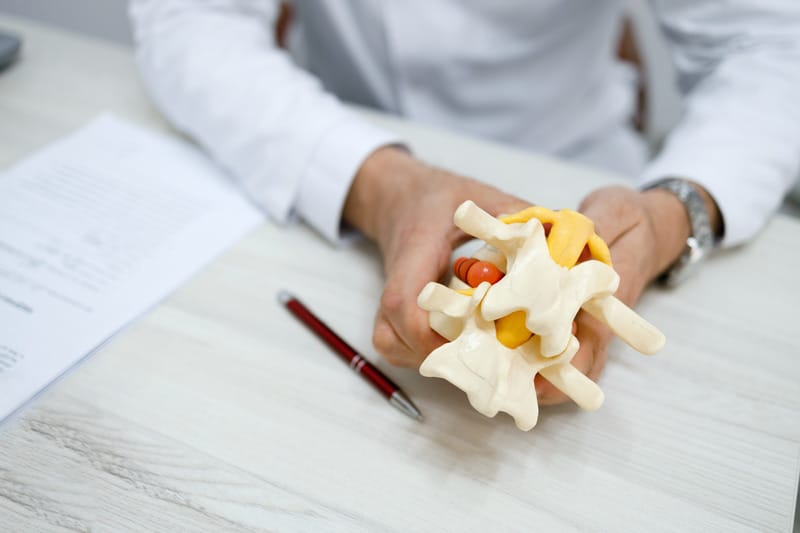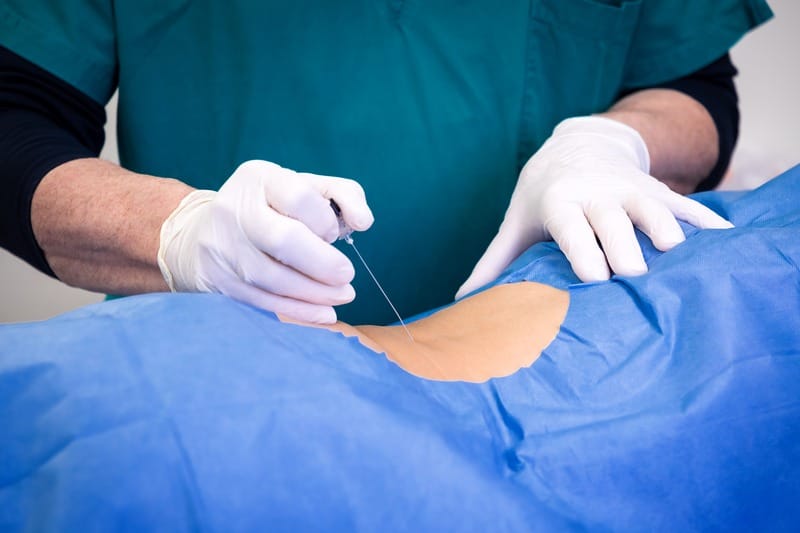Procedures that reduce pressure on the spinal cord or nerves are known as spinal decompression; these can be surgical or nonsurgical. A number of spinal conditions, such as herniated discs, spinal stenosis, or degenerative disc disease, cause this pressure. Spinal decompression is intended to decrease pain, numbness, and other symptoms related to spinal compression.
What causes spinal compression?
Spinal compression can be the result of a variety of spinal conditions, including herniated discs, spinal stenosis (a narrowing of the spinal canal), degenerative disc disease (breakdown of discs between vertebrae), spinal tumors, spinal injuries, or osteoarthritis. There are also lifestyle things that can lead to spine compression, where you’re a bit overweight, your posture is poor, or you don’t exercise enough on a regular basis.

Symptoms of spinal nerve compression?
Symptoms from spinal nerve compression vary depending on which nerves are compressed. You may have pain, numbness, tingling, or weakness in the affected area. Pain may be sharp or dull and may radiate to the other areas of the body (e.g., the legs).
In other cases, spinal nerve compression can cause balance, coordination, or trouble with bowel and bladder functions. Spinal nerve compression is a serious condition that calls for medical attention, so if you have any of these symptoms, get medical help.
If you have been diagnosed, your medical care provider can make recommendations for the treatment to best fit your own needs.
Treatment and Preventions:
Here are some possible treatments and prevention strategies for spinal compression:
Treatment:
Non-surgical options: chiropractic, acupuncture, medication, spinal injections… all things aimed to make you feel better.
Surgical options: Laminectomy, discectomy, spinal fusion, spinal decompression surgery
Spinal Decompression Therapy

Spinal decompression therapy is a relatively popular treatment for chronic back pain, herniated discs, sciatica, and related conditions. This nonsurgical, noninvasive therapy has been effective in reducing pain and improving movement in many patients. This guide will cover everything you need to know about spinal decompression therapy, including how it works, what it treats, and its advantages and disadvantages.
Benefits of Spinal Decompression Therapy
Spinal decompression therapy is noninvasive and has one of its biggest benefits. Spinal decompression therapy requires no incisions, no anesthesia, and as little as one treatment per week unambiguously, making it more comfortable and less expensive in comparison to surgery. Additionally, it is a relatively pain-free treatment option that can be tailored to each patient’s own needs.
The technique is also very effective for those who have chronic back pain. This treatment is shown in studies to lower pain levels and increase mobility in those with herniated discs, sciatica, and other related conditions.
Risks of Spinal Decompression Therapy
Spinal decompression therapy is generally considered safe, but there are some risks.
- Mild to moderate pain or discomfort during treatment
- Headache or nausea
- Muscle spasms or cramping
- In rare cases, worsening of the condition or nerve root damage
Before you have spinal decompression therapy done, you should talk with your doctor about its potential risks and benefits.
What is lumbar decompression surgery?

When a patient has lumbar decompression surgery, the surgeon is able to render the patient unconscious, thus eliminating any pain. Then, the surgeon makes a small incision near the affected part of the spine and uses different tools to take out tissue or bones, putting pressure on the spinal column or nerves in the spine. remove pressing
It may include taking out part of a herniated disc, reluctant bone spurs, or enlarging the spinal canal. In other cases, spinal fusion may also be needed. It is common after the surgery for the patient to need to rest and take pain- or discomfort-relieving medication. Many patients stay in the hospital for a few days to make sure they heal well and to watch for any further problems. Relatively quick, with very little chance of developing into cancer, polyps may be serious enough to require surgery. They may need rehabilitation and physical therapy to help the patient regain strength and mobility in the back.
What does spinal decompression do?
Spinal decompression surgery is the procedure where pressure is relieved on the spinal cord or nerves in the back. This pressure can lead to a painful, numb, tingling, and/or weak feeling in the effect relieves pressure pain, numbness, weakness
The surgeon takes out part of a herniated disc, bone spurs, or other tissue that’s putting pressure on the spinal cord or nerves during surgery.
Surgery aims to reduce pain and improve movement. Spinal decompression surgery typically serves as a final option when nonsurgical treatments fail to alleviate your symptoms. The recovery time may vary from person to person or depending on the extent of surgery.
Non-Surgical Spinal Decompression
Treatment of conditions like herniated discs, sciatica, and spinal stenosis with a spinal decompression device is a non-invasive treatment. The treatment includes operating a motorized device that softly extends the spine, making negative pressure that might help alleviate pressure on the spinal cord or nerves.
The patient is fitted with a harness that will attach them to the device, with the device fitting on a special table. Then, the device applies a gentle pulling force to the spine so that the discs are repositioned and secure. Which is the device then repositioning the discs and easing
Most nonsurgical spinal decompression sessions require a series of treatments to achieve the optimal result. There is no pain with the treatment, and no anesthesia is necessary. There is likely to be some mild discomfort or soreness that will resolve quickly for patients after treatments. The treatment is painless; however, patients are likely to experience
For many patients with back pain, nonsurgical spinal decompression is a safe and effective treatment alternative to surgery. It might not be the right fit for everyone and should be discussed with a healthcare provider to see if it’s a good treatment decision for you.
Is spinal decompression damaging?
Spinal decompression is a relatively safe operation, but any surgery has risks. There are risks of some bleeding, infection, or nerve damage and adverse reactions to anesthesia with spinal decompression.
Spinal decompression surgery will relieve the symptoms in most cases, but it won’t be effective in rare cases and can also cause new symptoms. The risks of specific types of spinal decompression can vary from procedure to procedure or from patient to patient.
Risks of lumbar decompression surgery
Lumbar spinal stenosis is a narrowing of the spinal canal in the lumbar spine, compressing nerves. If the nerve is compressed, it can lead to back pain, leg pain, numbness, or weakness, limiting activities of daily living.
Look at the risks of lumbar decompression surgery that you need to be aware of before undergoing the procedure:
Like any surgical procedure, including lumbar decompression surgery, there is a risk of infection.
Proper hygiene practice and use (and taking when prescribed) of antibiotics are made to reduce the risk of infection.
Lumbar decompression surgery also places a patient in the risk category of blood clots. They can develop in the legs and travel to the lungs to form a pulmonary embolism. Your surgeon may recommend blood thinners or compression stocks to prevent blood clots.
Lumbar decompression surgery involves working around the nerves in the spine, and therefore, nerve damage can occur. Numbness or tingling may result or even paralysis. However, sometimes the damage may be permanent.
Nonetheless, lumbar decompression surgery is supposed to improve pain. However, it could also cause pain during the recovery process. Medication your doctor prescribes manages this pain.
Surgical Treatment:
Treatments for spinal compression may include surgery, depending on what is causing the compression. Generally, spinal decompression surgery refers to surgery to relieve pressure on the spinal cord or nerves. Removing a portion of the bone or disc that is pressing the nerves or widening the spinal canal to give them more room is one example.

The laminectomy procedure involves removing a vertebra’s lamina (back or posterior portion) in order to make more room in the spinal canal, and the discectomy procedure involves removing a herniated disc that compresses the spine. After decompression, spinal fusion surgery is often necessary to stabilize the spine.
Not all conditions require surgery; in fact, physical therapy, medication, and spinal injections are nonsurgical treatments that can often relieve symptoms so that surgery may be avoided.
What are the alternative treatments for spinal decompression?
Spinal decompression surgery, a common treatment for some spinal conditions, isn’t always the best treatment for everyone. Some alternative treatments to consider include:
- Chiropractic care is a non-surgical treatment that involves maneuvers and adjustments of the spine to relieve pressure on the nerves and speed up the healing process.
- Physical therapy: A physical therapist can teach you to create a plan that includes specific exercises and stretches to improve your spinal health and reduce pain.
- Massage therapy: The main benefits of laser therapy are that it can help circulation, relax the muscles, and promote relaxation, all of which can help with pain and discomfort due to spinal issues.
- Acupuncture: According to practitioners of traditional Chinese medicine, acupuncture is a method of stimulating specific points in the body to reduce pain or to ‘influence’ the natural spiritual energy called ‘qi’ (or chi) and thereby encourage natural healing processes.
Prevention:
- Good posture and body mechanics during daily activities
- You remain active, exercising regularly and stretching for spinal health and flexibility
- A healthy weight to avoid putting stress on the spine.
- Staying away from sitting or standing too long and in one position
- Avoiding strain on your spine by using ergonomic furniture and furniture at work and home
Conclusion:
Spinal decompression therapy is a technique that is not invasive and utilizes a traction device to relieve pressure around the spine, in the spinal cord or nerves in the back. This treatment is also often a non-invasive technique for back pain and related conditions. On the spinal cord and nerves
Risks of treatment include mild to moderate pain or discomfort, headaches, nausea, muscle spasms, cramping, rare cases of nerve damage, or further worsening of the condition. Treatment risks and Although it’s not a good option for everyone, it’s a safe and effective alternative to surgery. If you want to know if spinal decompression is the right treatment for you, it is important to speak with a healthcare provider. Conditions such as herniated discs, spinal stenosis, or other related nerve and spinal injuries are treated by removing a portion of the bone or disc material that is pressing on the nerves or spinal cord during surgery.
The surgery is rarely needed, but even when it is, it may not get rid of the symptoms or may lead to new symptoms.
Spinal decompression. Please discuss with a healthcare provider the risks and benefits of spinal decompression and carefully consider options before having it done. According to the provider, he can identify if it’s the right choice; guided by needs, the provider can advise treatment options.
FAQs
How long does spinal decompression therapy take?
Spinal decompression therapy typically takes between 20 and 45 minutes per patient's recommended treatment course of 20 to 28 sessions.
Does spinal decompression therapy hurt?
Spinal decompression therapy is a relatively pain-free treatment option. However, some patients may experience mild to moderate discomfort during treatment.
what are spinal decompression surgeries?
Doctors use spinal decompression surgeries to relieve pressure on the spinal cord and nerves in the spine.
During surgery, a portion of bone or disc material that is pressing on the nerves or spinal cord is removed. This surgery is typically performed to treat conditions such as herniated discs, spinal stenosis, or other underlying nerve and spinal injuries.
is it good to decompress your spine?
Yes, decompressing your spine can be beneficial in relieving pain and other symptoms associated with spinal cord and nerve compression.
What Is Surgical Spinal Decompression?
Doctors use surgical spinal decompression to relieve pressure on the spinal cord and nerves. It involves removing bone or disc material that is causing the pressure, which can alleviate pain and other symptoms.
what is Metastatic spinal cord compression?
Spinal cord compression can result from cancer spreading to the spine, causing symptoms like pain, weakness, numbness, and bladder/bowel problems.
What are the risks of lumbar decompression surgery?
Like any surgical procedure, lumbar decompression surgery involves certain risks. While the procedure is generally safe, there are still potential complications that patients should be aware of. Lumbar decompression surgery poses several potential risks, including but not limited to infection, bleeding, nerve injury, and leakage of spinal fluid. Furthermore, there is a possibility of the spinal condition reoccurring or new symptoms emerging after the surgery.
what tests determine the severity of the injury?
To determine the severity of a spinal injury and whether lumbar decompression surgery is necessary, a doctor may order various tests.
Doctors frequently use an MRI (magnetic resonance imaging) as a diagnostic procedure that employs a strong magnetic field and radio waves to generate detailed images of the spine.
This imaging technique can reveal the magnitude of harm to the spinal cord or nerves and also identify the location of spinal cord compression.



Comments are closed.